
Art Deco Carlton Ware 'Jazz Stitch' Vase, c.1930s
An Art Deco Carlton Ware 'Jazz Stitch' vase, Carlton Ware, pattern no. 3655, c1930s, the ovoid vase decorated in colours with geometric design, reserved on an orange lustrous ground, marked underside with painted and impressed marks. Height 17 cm

Art Deco Carlton Ware Chevron Vase in Black and Green
An Art Deco Carlton Ware 'Handcraft' chevron vase, Carlton Ware, pattern no. 3657, 1932-1936, the globular vase boldly decorated in black and silver chevron and triangular motifs to the bulbous body on a vibrant Art Deco mid green ground, the lower…

Graduated Carlton Ware Anemone Pattern Serving Dishes, 18.5-22.5 cm
A graduated pair of Carlton Ware ceramic Anemon pattern serving dishes, length 18.5-22.5 cm
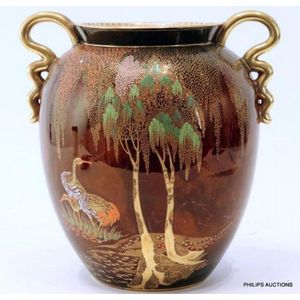
Carlton Ware 'New Stork' Vase with Gilt Handles, c1950s
A large Carlton Ware 'New Stork' two-handled vase, Carlton Ware, shape 1693/K, pattern 4340, c1950s, the fine ovoid vase with gilt scrolled handles, decorated in the 'New Stork' pattern with exotic wading birds grazing in water under trees, upon a deep…

Large Carlton Ware 'Mikado' Bowl with Oriental Ladies and Birds
A large Carlton Ware 'Mikado' bowl, pattern 4433, body shape 298 (largest), second quarter 20th century, the circular bowl painted to the interior with oriental ladies in pagodas and bridges landscape with kissing birds in flight above, on a 'Rouge…

Mid 20th Century Carlton Ware 'Mikado' Ginger Jar, Pattern 4433
A Carlton Ware 'Mikado' ginger jar, pattern 4433, body shape 315, mid 20th century painted with a reduced version of the 'Mikado' landscape on a 'Rouge Royale' type ground, the gilt-finialed cover conforming, impressed and later version gold printed…

Carlton Ware 'Duck' Pattern Oval Dish with Mallard Ducks
A Carlton Ware 'Duck' pattern dish, mid 20th century, the low sided scallop edged oval dish with a single handle, painted to the interior with two realistic Mallard ducks flying off above irises and wild grasses on a 'Rouge Royale' type ground, with…

Chinoiserie Pagoda Vase on Black and Green Ground
Carlton Ware Chinoiserie pagoda pattern vase on rare black and green ground, early W. & R. Swallow mark to base, 15 cm high

Large Carlton Ware Rabbit Vase with Crack
Good large Carlton Ware 'Rabbits at dusk' vase Circa 1940, Decoration Pattern 4247, Body Shape 1674, the Exterior Decorated with Rabbits in Silhouette at the Base of a Tree on a Mottled Orange Lustre Ground, the Interior Green-Glazed, Painted and Printed…

Red Tri-Footed Carlton Ware Bowl with Gilt Highlights
Carlton Ware 'Bell' pattern tri-footed bowl red background with enamel and gilt highlights, height 9.5 cm, width 23.5 cm

Carlton Ware Rouge Jug with Secretary Bird Pattern
Good large Carlton ware jug with red rouge background and 'Secretary Bird' pattern, with enamel highlights and gilded handles, height 20 cm

Carlton Ware Mikado Jug with Enamel and Gilded Details
Large Carlton ware jug with blue background and Mikado pattern, enamel highlights and gilded handles, height 20 cm

Rare Carlton Ware 'River Fish' Jug
Rare Carlton ware 'River Fish' jug also known as 'Shabunkin' pattern 3971, barrel form jug with a gilded bracket handle, decorated with a vibrantly enamelled fish and one other, height

Carlton Ware Long Tailed Bird Trio
A Carlton ware 'Long Tailed Bird' pattern trio (also known as 'Feather') mottled green ground gilded. Number 3355.

Carltonware Lustre Jug with Lilac Flowers
A Carltonware lustre jug 'Moderne' gilt handled, decorated with lilac flowers on a mottled pale green ground. Pattern 4310, height 17 cm

Carlton Ware Stork Jug, Green & Gold, 18cm
A Carlton ware 'New Stork' pattern, famille noir enameled jug Green inner, gilded handle, height 18 cm

Carlton Ware Rabbit Tray with Gilt Highlights
A Carlton ware lustre tray 'Rabbits at Dusk' pattern oval with integral handles highlighted with gilt, length 23.5 cm, width 13 cm
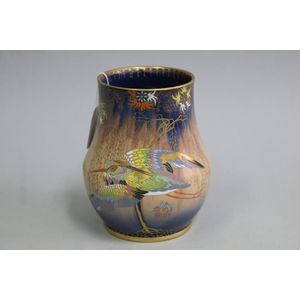
Carlton Ware Sketching Bird Vase
Carlton Ware Sketching Bird pattern vase, no 3890, c1935-39, 16 cm high, 13 cm diameter

Carlton Ware Bell Pattern Vase with Red Lustre Ground
A Carlton Ware 'Bell' pattern vase squat ovoid shape, pattern no.3788, printed and painted in colours and gilt on a red lustre ground (crazing to the red lustre). Printed and painted marks, height 14 cm

Geometric Art Deco Crown Devon Vase by Enoch Boulton
An Art Deco Crown Devon vase by Enoch Boulton, (former design manager for Carlton Ware) geometric, with circles in red, black, blue with yellow/white striped ground (see back cover of Crown Devon book) pattern A20, height 20.5 cm

Carlton Ware Noire Royale Stork Lidded Box
A Carlton Ware Noire Royale lidded box new stork pattern on black ground. 14 x 10 cm

Carlton Ware Noir Royale Enamelled Stork Vase
A small Carlton Ware Noir Royale enamelled vase new stork pattern on black ground. Waisted, wavy handles, height 9.5 cm

Carlton Ware Lacecap Hydrangea Demi-Tasse Set
A Carlton ware enamelled part demi-tasse coffee set Lacecap hydrangea pattern number 3967 ruby lustre. Comprising: coffee pot, creamer, sugar bowl, six saucers and five cups

Carlton Ware Sketching Bird Dish
A Carlton ware dish, 'Sketching bird' pattern shallow conical shape on conforming foot, gilded and enamelled in pink, cream, on a black ground, diameter 18 cm

Carlton Ware Rabbit Lustre Jug
A Carlton ware lustre jug, 'Rabbits at Dusk' pattern squat circular, with bright green interior, height 65, diameter 13.5 cm

Jade Chevron Carlton Ware Vase, Restored
A Carlton ware Chevron 'Handcraft' vase ovoid, silver and black chevron pattern on jade green ground, pattern number 3657. Professional restoration to foot rim, height 19 cm

Lustre Glazed Carlton Ware Ginger Jar
A large W&R Carlton Ware 'Chinaland' ginger jar, c.1925 pattern 2948, lustre glazed and gilded orange ground, height 26 cm
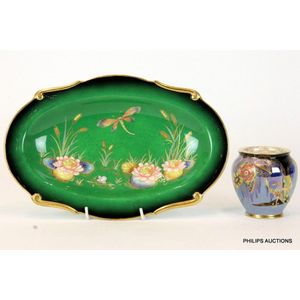
Carlton Ware Vase and Dish with Bird and Lily Designs
Two Carlton Ware items, comprising a Secretary bird pattern vase (1937-1941) in the steel blue lustre ground, stamped to the underside with painted numbers M1/2245 4106; and a water lily oval dish (c1950, pattern 4436, the lilies and dragonfly design…

Carlton Ware Tutankhamun Ginger Jar with Egyptian Designs
Large and impressive Carlton Ware Tutankhamun pattern ginger jar ovoid form with dome lid. The lid with Egyptian mask finial decorated in coloured enamels with Egyptian designs on a rich blue ground. Created to celebrate the opening of Tutankhamun's tomb…

Carlton Ware Lustre Vase - Rabbits at Dusk
A Carlton Ware lustre vase in the 'Rabbits at Dusk' pattern. Irene Pemberton (des.) pattern 4247 (intr. 1939) in shape 1640, circa 1950. The delightful small ovoid form vase in orange lustre with pink stippling, in the 4247 pattern also known as 'Shadow…
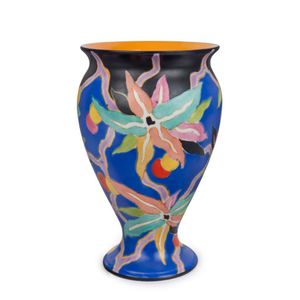
Art Deco Carlton Ware Stellata Vase
Carlton Ware 'Stellata' pattern Art Deco English porcelain vase, circa 1930, blue factory mark 'Carlton Ware, made in England, trade mark, Handcraft', 24.5 cm high

Art Deco Carlton Ware Jug with Gum Flowers
A Carlton Ware jug in the gum flower pattern, pattern no 3790 circa 1930, the Art Deco bulbous jug, hand enamelled with striking gum flowers, leaves and gumnuts on mottled greenish ground, with gilded handle and rim, stamped and painted marks underside,…

Carlton Ware 'Day Oak' Jug - 31.5cm
Large Carlton Ware 'Day Oak' pattern jug ribbed baluster shape, 31.5 cm high

Bleu Royale Pagoda Charger - 38 cm Diameter
Carlton Ware Bleu Royale charger pagoda pattern 38 cm diameter

Carlton Ware Rouge Royale Mikado Ginger Jar
Carlton Ware Rouge Royale covered ginger jar new Mikado pattern #125/5 still with paper label 16 cm high
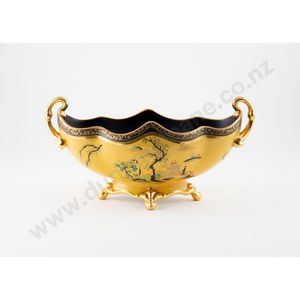
Carlton Ware Jaune Royale Fruit Dish with Chinoiserie Pattern
Carlton Ware Jaune Royale shaped oblong fruit dish Chinoiserie type pattern with black matt interior glaze on pedestal foot with split scroll handles, early printed mark circa 1894 33 cm

Carlton Ware Bleu Royale Mikado Trumpet Vase
Carlton Ware Bleu Royale trumpet vase new Mikado pattern impressed #1692/H 18 cm high
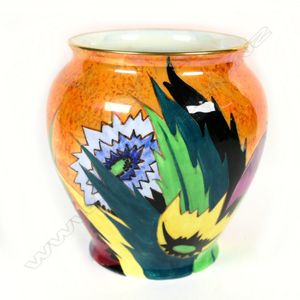
Carlton Ware Anemone Lustre Vase
A Carlton Ware 'Handcraft' Anemone pattern vase, bright lustre tones, geometric forms, gilt rim. Pattern #3694, c.1932, a striking uncommon example. Height 11.2 cm.

Lustrous Carlton Ware Parkland Vase with Gilt Highlights
A Carlton Ware Parkland vase, the lustre bright tones on matte green ground, gilt highlights. Pattern #3524. Height 13.7 cm.

Chinoiserie Baluster Vase with Enamel Scenes and Cracked Ice Bands
A large W & R Carlton Ware vase, 1894-1927 stamp, pattern 3027 post 1923, the temple pattern baluster vase with trumpet neck featuring Chinoiserie scenes of figures in pavilion and lakeside pleasure gardens in enamel colours upon an ivory ground, with…

Carlton Ware Bleu Royale Pagoda Vase with Gilt Handles
Carlton Ware Bleu Royale pagoda pattern vase, baluster shape with twin gilt scroll handles and fluted lower section, 23 cm high

Carlton Ware Shabunkin Fish Vase by Violet Elmer
Rare Carlton Ware Shabunkin river fish pattern vase, ovoid shape, attributed to Violet Elmer, decorated with a fish swimming amongst pond reeds on a modulating light green ground, (hairline crack to the interior) factory stamp, 14 5 cm high

1930s Carlton Ware Fan Pattern Bomb Vase, 24cm Height
Art deco Carlton Ware 'Fan pattern' bomb vase circa 1930's, height 24 cm

Carlton Ware Garden Lustre Ware Posy Vase #1460/3478
Carlton Ware Garden pattern lustre ware posy vase marked to base and # 1460/3478, height 8 cm.

"Wild Duck" Carlton Ware Coffee Set
Carlton Ware 6 Rouge Royale coffee cups & saucers pattern: Wild Duck

Carlton Ware Pagoda Sugar Bowl with Lid & Plate
Good Carlton Ware lidded sugar bowl Pagoda pattern, with under plate, marked to bases and # 2910, height 10 cm.

Hand painted Carltonware vase in 'Violet' pattern, 13.5 cm
Rare Carltonware 'Violet' pattern hand painted vase, height 13.5 cm

Carlton Ware Pagoda Card Box
Carlton Ware pagoda pattern card box pagoda decoration to lid, marked to base, length 13 cm.

Carlton Ware Rouge Royale Chinoiserie Demitasse Service
A Carlton Ware Rouge Royale 'New Stork' pattern service, circa 1951, pattern introduced 1938 and attributed to Irene Pemberton, comprising a four person demitasse setting with coffee pot, creamer, sugar, bowl, bon bon tray, and a large display jug, in…
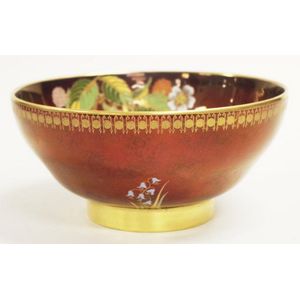
Dragonfly & Spiderweb Carlton Ware Serving Bowl
Carlton Ware 'Rouge Royale' serving bowl dragon fly and spider web pattern, marked to base, diameter 20 cm.

Carlton Ware Fruit Coffee Set & Posy Vase
Good Carlton Ware part coffee set fruit and berry pattern on pink ground including 4 coffee cups with gilt interior, and saucers, plus 2 additional saucers, lidded sugar bowl, cream jug, coffee pot; plus a Carlton Ware posy vase.

Carlton Ware Rouge Royale Serving Dish with Dragonfly Design
Carlton Ware 'Rouge Royale' serving dish dragon fly and spider-web pattern, marked to base, length 30 cm.

Art Deco Carlton Ware Metropolis Vase
An Art Deco Carlton Ware 'Handcraft' Metropolis pattern vase, circa 1939, of compressed form, in bold colours illustrating the 1939 World's trade monuments: the Trylon and Perisphere, pattern no. 3420 s/2695 to base. 21.5 cm high,

Ruby Lustre Heron and Tree Vase
A Carlton Ware 'Heron and Magical Tree' vase, 1937-1941, production period, shape 1641, the baluster vase with a rope twist base featuring two brightly coloured, flying herons and a stylised sinuous tree in gilt with fan shaped foliage and enamel coloured…

Carlton Ware Lace Cup & Palm Blossom Vases, 1930s
Two Carlton Ware vases 'Lace cup Hydrangea', palm blossom, circa 1935, 1939, patterns 3969 and 4297, shape 466, a 'Lace cap Hydrangea' ovoid vase in enamel colours with gilt enrichments, upon a lustre pale blue ground suffused with pink, and a 'Palm…

Carlton Ware Vases and Cup with Pagoda and Floral Patterns
Three various Carlton Ware vases and a cup two vases with pagoda pattern, the other a floral spray, the cup with new stork pattern, height 11.5 cm
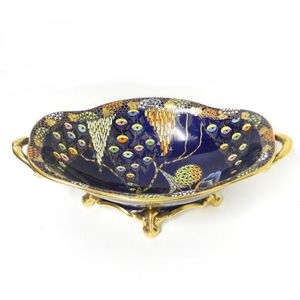
Carlton Ware Devil's Copse Lozenge Bowl
A Carlton Ware 'Devil's Copse' pattern lozenge shaped bowl, decorated in bright enamels and gilt with trees bearing 'eye' fruit along with exotic paddle and spearpoint flowers on a cobalt ground, raised on gilded ball and claw feet, and with gilded…

Hand-painted Persian Carlton Ware lidded vase
A hand painted Persian pattern W & R Carlton Ware, lidded vase early Wiltshaw & Robinson Ltd mark 1894-1905, height 31.5 cm
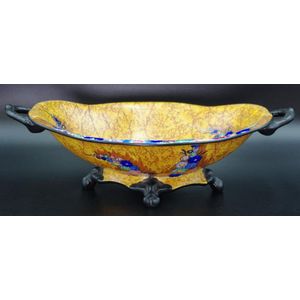
Orange Hollyhocks Carlton Ware Footed Bowl with Handles
Carlton Ware orange Hollyhocks pattern footed bowl with twin handles, original sticker to base, width 33 cm

Carlton Ware Australian Tea and Coffee Service, 1950 'Windswept'
Carlton Ware Australian design tea and coffee service, c. 1950, 'Windswept' pattern, comprising a coffee pot, a teapot, two cream jugs, two sugar bowls, a butter plate and cover, seven dessert plates, six cups and saucers, retain manufacturer's printed…

Teal Bluebell Carlton Ware Ewer Vase - 36cm Height
A large Carlton Ware ewer vase, teal glaze with bluebells pattern moulded and coloured to the walls, height 36 cm
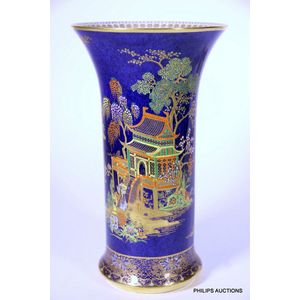
1923 Carlton Ware Chinoiserie Vase with Mikado Pattern
A W & R Carlton Ware 'New Mikado' vase, circa 1923, pattern 2727, the cylindrical vase with flaring rim, decorated throughout with a Chinoiserie, design featuring pavilions and pleasure boats in a garden setting, in enamel, colours with gilt enrichments…

Mikado Candlesticks by W&R Carlton Ware, 1920s
A pair of W & R Carlton Ware 'Mikado' candlesticks, 1924-1927 period, pattern 2881, design attributed to Enoch Bolton, shaped pillar sticks with cup shaped sconces and wells, decorated with, oriental figures, pavilions and landscapes in enamel colours…
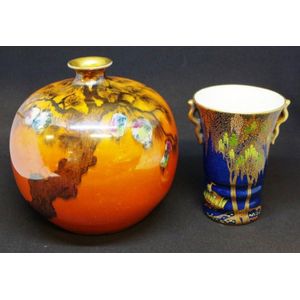
Vintage Ceramic Vases: Carlton Ware & Wilkinson Burslem
Two good English vintage ceramic vases including Carlton Ware, 'Heron and Magical Tree,' pattern, marked to base and # 1692D, height 12 cm; and a Wilkinson Burslem lustre vase, Tree with Chinese lanterns decorated, height 16 cm

Carlton Ware Pedestal Cup with Mikado Pagoda Design
A Carlton Ware pedestal cup, Early/mid 20th century, backstamp of 1925-1970 period, probably Mikado pattern, a variation of 2364, decorated externally with a pagoda, pavilion and trees in enamel colours on a mottled blue ground, with, lace like gilded…

Carlton Ware Garden Gate Wall Plaque
A Carlton Ware wall plaque, decorated in the garden gate pattern, introduced in the 1930s and designed by Violet Elmer, some crazing to the centre, diameter 31.5 cm.

Art Deco Carlton Ware Sketching Bird Vase
An Art Deco Carlton Ware vase, in the Sketching bird pattern, etched mark and paper label to base. 9 cm x 15 cm.

Carlton Ware Trumpet Vases with Oriental Designs
Two small trumpet vases, W & R Carlton Ware 'Temple' and Carlton Ware, Mikado, mid to late 1920s, patterns 2929 and 2881, both with oriental designs in enamel colours, 'Temple' in mid blue with a cracked ice black and gold rim, 'Mikado' in matt black with…
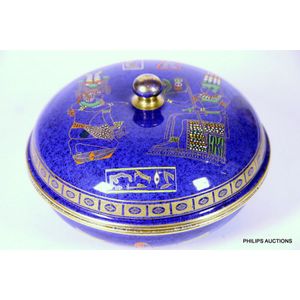
1922 Carlton Ware Tutankhamen Dish & Cover
A W & R Carlton Ware 'Tutankhamen' dish and cover, circa 1922, pattern 2711, design attributed to Enoch Bolton, a circular bowl and cover decorated with Egyptian figures and motifs in enamel colours and gilt on a mottled blue ground, backstamps including…
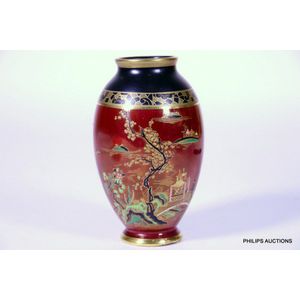
1927 Carlton Ware Temple Vase with Oriental Motifs
A W & R Carlton Ware 'Temple' vase, circa 1927, design attributed to Horace Wain, a small baluster vase with oriental temples, kakiemon style trees and a figure on a bridge in enamel colours upon a blood red ground, with a gilt, brocade border to a matt…
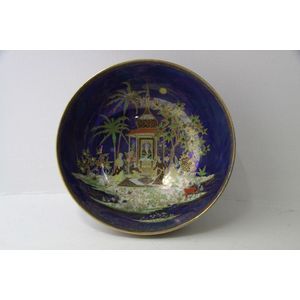
Lustre Bowl with Persian Figures by Carlton Ware
A Carlton Ware Persian pattern design lustre bowl decorated with figures. 10 cm high, 23 cm diameter.

Art Deco Carlton Ware Ginger Jar - Mikado Pattern
An Art Deco Carlton Ware ginger jar c.1920 - 1930's in the Mikado and temple pattern, height 37 cm

Carlton Ware Mikado Pattern Vase with Foo Dog Finial
Large Carlton Ware Mikado pattern lidded vase, with foo dog finial, and original Bazar Colon's sticker to base, height 36 cm

Hand-painted Carlton Ware flambe vase with floral pattern
Carlton Ware flambe vase hand-painted with bold enamel floral pattern, 24 cm height

Carleton Ware 'Rabbits at Dusk' Vase
A Carlton Ware 'Rabbits at Dusk' vase, circa 1938, pattern 4247 attributed to Irene Pemberton, in shape 456 in use until 1941, in mottled orange lustre colours depicting rabbits in silhouette beside sinuous trees, tall cypress to the reverse, an apple…

Carlton Ware Red & Black Covered Vase, 1900 & 1920
Red & black Carlton Ware (Wiltshaw & Robinson) covered vase c.1900 Carlton Ware covered vase Kiang Hsi pattern c.1920

Carlton Ware Chevron Vase with Silver Overlay
A Carlton Ware 'Handcraft' Chevron pattern vase, silver geometric overlay to the green and black glaze. Printed and painted marks. Height 7.5 cm

1935 Carlton Ware Red Devil Bowl
A Carlton Ware bowl with Red Devil Pattern (Mephistopheles). Original paper label to base, circa 1935, 23.5 cm diameter

Bluebells Vase by Carlton Ware (1934-1939)
Carlton Ware 'Bluebells' vase blue flushed to white lustre ground, pattern 3872, production era 1934 to 1939. Height 10.2 cm

"Paradise Bird & Tree" Carlton Ware Vases
Carlton Ware 'Paradise Bird & Tree' pair of vases of cylinder shape, on a blue lustre ground. Pattern number 3155, production era 1927 to 1931, with original price stickers, height 14.8 cm

Carlton Ware Pagoda Rouge Sandwich Dishes
Four various Carlton Ware rouge sandwich dishes, all Pagoda pattern, with gilt highlights. Length 25 cm (largest).

Pagoda Pattern Carlton Ware Rouge Royale Bowls Set
Three various Carlton Ware rouge royale bowls, all Pagoda pattern, including pair shallow bowls, and one footed bowl, diameter 19 cm (pair bowls).

Pair of Carlton Ware Rouge Serving Bowls
Two various Carlton Ware rouge serving bowls, including one with Pagoda pattern, the other plain, with gilt rim and foot, diameter 25 cm (larger).
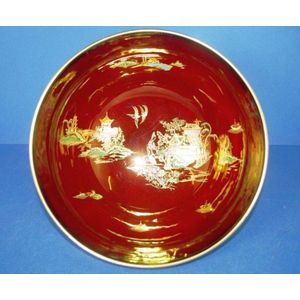
Carlton Ware Rouge Pagoda Serving Bowl with Gilt Highlights
Carlton Ware rouge serving bowl, Pagoda pattern, with gilt highlights, diameter 25.5 cm Height 12 cm

Carlton Ware Swallow and Trees Ginger Jar
A large Carlton Ware 'Swallow and trees' ginger jar, production period 1928-1929, a variant of pattern 3279, in a pearlised pale blue grey colour with a fine pendant collar of tree foliage in cobalt and mauve colours richly scrolled with gilt, with birds…

Carlton Ware Sketching Bird Ginger Jar
A Carlton Ware 'Sketching Bird' ginger jar, 1935-39 production period, pattern 3952, shape 125, the jar decorated with a bird embellished with pink, blue, orange and green enamel colours flying through a landscape with gilt willow trees, a delicate gilt…
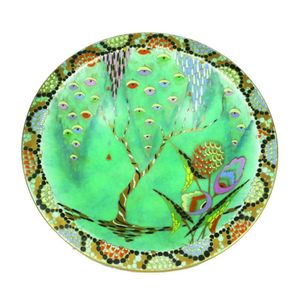
Carlton Ware Devil's Copse Cone Bonbon Bowl
An uncommon Carlton Ware 'Devils Copse' pattern 3767 'Cone' bonbon bowl, shape S797, matt mottled turquoise background, designed by Violet Elmer, c.1935. Diameter 23 cm

Carlton Ware Rouge Royale Pagoda Vase, 28 cm Height
A Carlton Ware Rouge Royale pagoda pattern vase, in excellent condition, no signs of damage, with original Carlton Ware paper label to base, height 28 cm
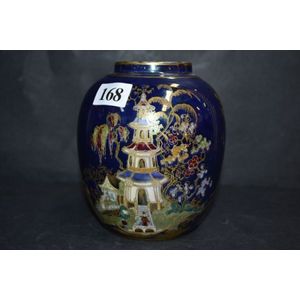
Lustre Vase: Carlton Ware 'China Land', 12cm, #2950
Carlton Ware 'China Land' ovoid lustre vase, height 12 cm, pattern no. 2950

Carlton Ware Forest Tree Urn Vase
Carlton Ware 'Forest Tree' lidded urn vase, height 28 cm, pattern no. 3244

Tall Carlton Ware 'New Mikado' Vase - 26cm, #2728
Carlton Ware 'New Mikado' tall cylindrical vase, height 26 cm, pattern no. 2728

"Devil's Corpse" Carlton Ware Vase (20cm) - #3787
Carlton Ware 'Devil's Corpse' vase, height 20 cm, pattern no. 3787

Carlton Ware Fighting Glade Vase, 9.5cm, Pattern 4212
Carlton Ware 'Fighting Glade' small vase, height 9.5 cm, pattern no. 4212

Carlton Ware Fish Jug
A striking Carlton Ware 'River fish' jug, circa 1935, also known as 'Shabunkin' pattern 3971, the barrel form jug with a gilded bracket handle and a waisted base, decorated with a vibrantly enamelled fish and one other in shadow behind, further…

"Fighting Cocks" Carlton Ware Vase
A Carlton Ware 'Fighting Cocks' vase, 1937-1941, pattern 4161, shape number 1695, the tapering vase with a beehive base and gilded chilong style handles decorated with tracery style foliage and flowers in bright enamel colours and a rooster with splendid…

"Floral Comets" Carlton Ware Yen Yen Vase, 1929
A Carlton Ware 'Floral Comets' Yen Yen vase, circa 1929, pattern 3405, with design attributed to Violet Elmer, shape 139, with clusters of autumn and purple toned flowers to the rim and base upon arcs of blue, mauve, and blue mottle interspersed with…
 Loading more...
Loading more...